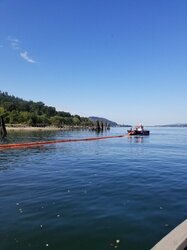A Short Guide to River Boom Deployment by West Coast Spill Supplies
March 14th 2024

Maintaining the health and cleanliness of our waterways is a critical responsibility. In regions like British Columbia and Alberta, where rivers play a central role in the environment and economy, effective solutions for managing floating debris, pollutants, and potential hazards are essential. Enter river booms – versatile tools provided by companies like West Coast Spill Supplies – designed to safeguard our water bodies. In this article, we will dive into the process of deploying a river boom, highlighting key steps and considerations for success.
Step-by-Step Deployment Guide
1. Assessment and Planning:
Before deploying a river boom, conduct a thorough assessment of the site. Identify the nature of the water flow / current, potential obstacles, and the type of debris you aim to manage. Collaborate with West Coast Spill Supplies to determine the appropriate boom type and size for your specific needs. When spec’ing river boom it is important to have a top tension member for additional tensile strength, rendering the boom more stable in fast currents. A heavy ballast chain is also key to ensure that the boom skirt does not lift in fast currents.
2. Preparation:
Gather all necessary equipment, including the river boom, anchor systems, ropes, and any additional tools required for installation. Ensure that the boom is properly inspected, free from damage, and ready for use.
3. Safety Precautions:
Safety is paramount. Ensure that your team is equipped with appropriate personal protective equipment (PPE),including life jackets and helmets. Communicate safety protocols and emergency procedures before beginning the deployment process.
4. Boom Unrolling:
If the river boom is stored, unroll it on a clean and flat surface. Carefully examine the boom for any potential snags or twists. Lay out the boom sections in the order they will be connected.
5. Connecting Sections:
Attach the boom sections using the provided connectors or couplings. Follow the manufacturer's guidelines and make sure the connections are secure to prevent separation during deployment.
6. Anchor Placement:
Choose appropriate anchor points along the riverbanks to secure the boom. The number and type of anchors depend on factors such as water flow, boom length, and environmental conditions. Proper anchoring prevents the boom from drifting or being pushed by currents.
7. Deploying the Boom:
Slowly release the boom into the water, allowing it to float on the surface. Work methodically to ensure the boom sections are aligned and positioned correctly. Use a boat or raft to guide the boom into the desired configuration.
8. Adjusting and Aligning:
As the boom is deployed, adjust its position to account for current and wind conditions. Maintain a consistent distance between the boom and the water surface to ensure optimal debris collection.
9. Securing the Ends:
Once the boom is correctly positioned, secure the ends to the anchor points on each riverbank. Ensure the connections are tight and the boom is taut to prevent slack that could hinder its effectiveness.
10. Regular Monitoring:
After deployment, monitor the boom's performance regularly. Clear any debris that accumulates against the boom and make adjustments as needed to maintain its effectiveness.
Deploying a river boom is a process that requires careful planning, coordination, and a commitment to safety. West Coast Spill Supplies is a provider of river booms in British Columbia and Alberta, and across all of Canada, who offers a range of solutions to suit various environmental and spill control needs. From containing pollutants such as oil and other hydrocarbons, to preventing debris accumulation, river booms play a pivotal role in safeguarding our waterways.
By following the steps outlined in this guide, you can effectively deploy a river boom to protect your local aquatic ecosystem, ensure safe navigation, and contribute to the overall health of our environment. As stewards of our water bodies, it's our responsibility to embrace solutions like river booms that not only address immediate challenges but also contribute to a sustainable and thriving future for all.
Learn more about our various Inshore containment boom options, including lightweight, economical, and easy-to-deploy River Containment Booms.
Learn More about our River Booms
